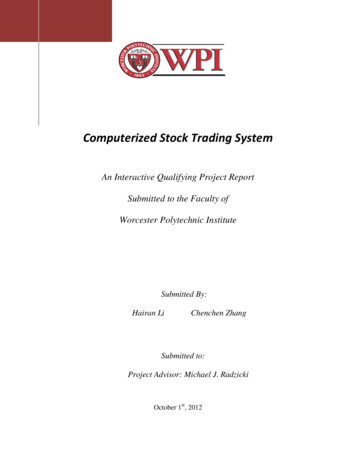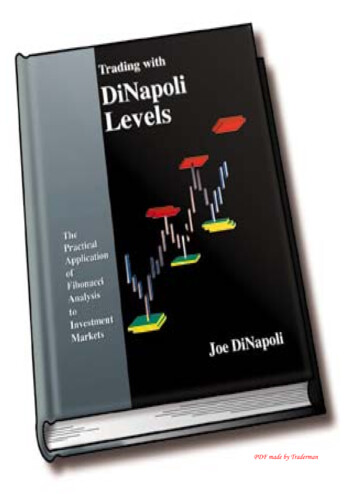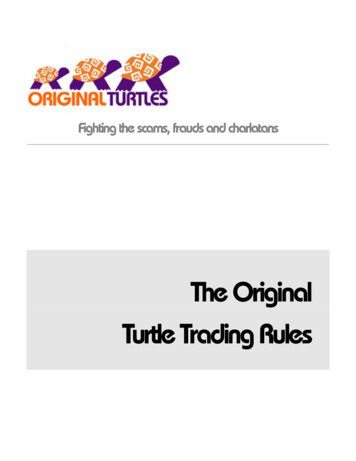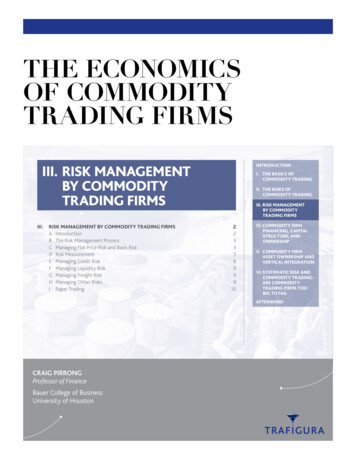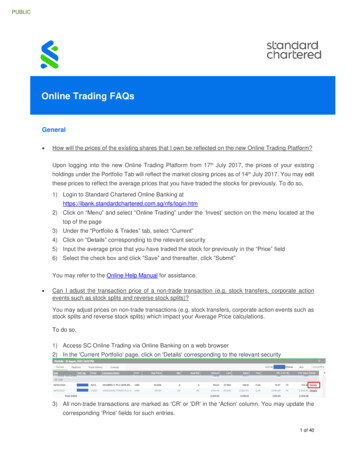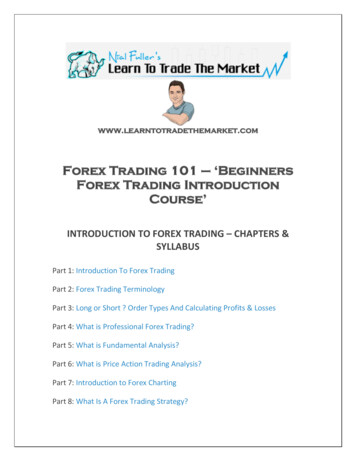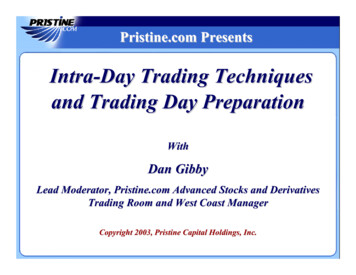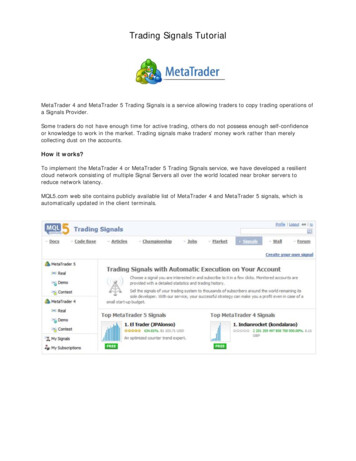
Transcription
A Trading System development tutorial for theAmiBroker Stock Charting/Analysis programBy Herman van den Bergen, Monday, July 29, 2002.This tutorial was prepared in response to a post by Dimitris Tsokakis, on the AmiBrokerUsers list, in which he introduces the basic idea for a StoCCI system (see text on page 2).The procedures used below reflect personal design philosophy and preferences. I do notuse any commissions or interest in my calculations, if these play a role the system it is soweak that I discard it. You may or may not agree with my approach, either way Iencourage you to express your opinion on the AmiBroker list. It is only through frankdialogue and criticism that we can improve our skills. Kindly report any errors oromissions to me privately: psytek@rogers.com“The Starting Position”Profits: 143% for the period 4/12/00 to 7/26/02Important Note: This report outlines typical procedures that you may use to develop atrading system. Do not trade this system as is; no profitability is suggested or implied.Author: Herman van den BergenPage 1 of 1
Dimitris’ PostPosted on amibroker@yahoogroups.comBy: Dimitris Tsokakis [TSOKAKIS@ONEWAY.GR]Subject: [amibroker] TranformationsDate: Mon 7/29/02 5:41 AMSuppose you trade INTC with a Stochastic CCI [6,12,70] system.The total % net profit, after 18trades/12 winners/6losers is -15.85%See INTC1.gif[buy,sell,short,cover at open, delay 1, commission 0.5%, all stops disabled] with the use of the code:/*Smoothed Stochastic CCI*/P 6;D DateNum() 1000301;Blevel Optimize("BL",12,10,20,1);Slevel Optimize("SL",70,70,90,1);StOcci I(6),14));stocci MA(stocci,5);Buy Cross(STOCCI,BLEVEL);Sell Cross(STOCCI, Slevel);Buy D*(Buy);Sell D*Sell;Short Sell;Cover Buy;Buy ExRem(Buy,Sell);Sell ExRem(Sell,Buy);Short ExRem(Short,Cover);Cover ExRem(Cover,Short);E1 Equity();EM40 MA(E1,40);XB Flip(Buy,Sell);XS Flip(Sell,Buy);XSH 2*Flip(Short,Cover);XCO 2*Flip(Cover,Short);XBSH (XB XSH);XSXCO (XS XCO);ASC Cross(E1,EM40);DESC Cross(EM40,E1);// Buy ASC*(XBSH 1);Sell DESC*(XSXCO 1);//Short ASC*(XBSH 2);Cover DESC*(XSXCO 2);Do you want to transform the -15.85% to a 126% somehow automatically ?Simply delete the // from the last line !!6trades/5winners/1loser and that s it.See INTC2.gifDimitris TsokakisPS1. Any volunteers to improve this method and reach its final form with a co-operative work ?We may create a method belonging to this excellent list.This is my ambition. I know what to do for myself. With or, sometimes, without strict coding.PS2. The above combination [6,12,70] is just for the examplePS3. Some other examplesCSCO from 39% to 364%MSFT from -11% to 87%QQQ from 158% to 328%butORCL from 36% to 9% etc. etcThank you Dimitris, for this and many other interesting posts!Author: Herman van den BergenPage 2 of 2
The Tools1)2)3)4)AmiBroker EOD 4.07 beta (version 4.07.4, July 28,2002)Excel 2000 (3D charts, I don’t know if 3D macro works in other versions)Excel Plugin: ABOptimizer392c.zip (Makes 3D charts for you)AmiBroker User group (here you can join discussions and find support)Preliminary observations There are three periods that can be optimizedThe DateNum() has to be changed to allow out-of-sample optimizingThe usual smoothing of the Stochastic formula has been disabledThe LookBack period is rather largeCrossovers are not as usual and may need optimizingBefore adding signal gating (Equity Feedback) the basic formula should beoptimizedNo Stops are usedExRem statements may not be neededEquity(1) may be needed to ensure proper Buy/Sell signalsThe gating MA() uses a very long period of 40Selecting a test periodThere are many ways to do this however it is my personal preference to develop on data(starts 1/1/1997 for me) before 1/1/01 and perform out-of-sample testing on thesubsequent period of 1/1/01 to today. I will adopt these choices for this project.I disable the starting date by changing the second line of code(D DateNum() 1000301;) to (D 1; //DateNum() 1000301;).The System test SettingsTo duplicate this exercise you will need INTC data from 1/1/97 to today. I use QuotePlusdata, if you use another data source your results may be slightly different. Do not beconcerned about that; it is the procedures that are important, not the exact figures orprofits. Before starting you must make INTC your current stock, select it in yourworkspace. I use these three testing periods:Author: Herman van den BergenPage 3 of 3
Out-of-Sample periodDevelopment periodAuthor: Herman van den BergenFull HistoryPage 4 of 4
Crossover OptimizingWhen working with new systems I always first determine the optimum direction ofsignal-threshold crossings. This is a reversal system so there are only two ways theStoCCI indicator can cross the thresholds.If the system were utilizing cash positions there would be four possible combinations. Iperform this step on “All Quotations” because the system, at this stage, performs verypoorly; using a longer testing period will give me a better indication. I assume that theoptimum crossings remain constant for the system.For this test I also set the Threshold levels to “neutral” that would be 50 in this case. I dothis to prevent distortion of the results by far-out threshold choices. I use this code to testthe crossovers:/*Listing #1 - Smoothed Stochastic CCI*/TM Optimize("TML",1,1,2,1);//Determine optimum direction of crossingP 6; //Optimize("Pd",6,2,10,1); //Periods as provided by DimitrisLB 14; //Optimize("LB",14,1,20,1);Ps 1; //Optimize("Ps",5,1,6,1);D 1; //DateNum() 1000301;//Disable datenum()Blevel 50; //Optimize("BL",12,10,20,1); //Use neutral thresholdsSlevel 50; //Optimize("SL",70,70,90,1);StOcci I(P),LB));Plot(StoCCI,"StoCCI",4,1);StoCCI MA(stocci,Ps);Buy IIf(TM 1,Cross(STOCCI,BLEVEL),Cross(BLEVEL,STOCCI));Sell IIf(TM 1,Cross(Slevel,STOCCI),Cross(STOCCI,SLevel));Buy D*Buy;Sell D*Sell;Short Sell;Cover Buy;The clear winner, which I confirmed with tests over other periods (not shown) is TM 2.Modifying the basic formula we now have:/* Listing #2 - Smoothed Stochastic CCI*/P 6; //Optimize("Pd",6,2,10,1); //Periods as provided by DimitrisLB 14; //Optimize("LB",14,1,20,1);Ps 1; //Optimize("Ps",5,1,6,1);D 1; //DateNum() 1000301;//Disable datenum()Blevel 50; //Optimize("BL",12,10,20,1); //Use neutral thresholdsSlevel 50; //Optimize("SL",70,70,90,1);StOcci I(P),LB));Plot(StoCCI,"StoCCI",4,1);StoCCI MA(stocci,Ps);Buy Cross(BLEVEL,STOCCI);Author: Herman van den BergenPage 5 of 5
Sell Cross(STOCCI,SLevel);Buy D*Buy;Sell D*Sell;Short Sell;Cover Buy;Period OptimizingAll optimizations are performed on data from 1/1/1997 to 1/1/01. This reserves data from1/1/01 to today for out-of-sample testing.We have three (I am including Stochastic Smoothing which was disabled by Dimitris)that can be optimized. We can chart only two parameters vs. the gain at a time on a 3Dchart so I will need to make many charts to find the optimum parameters. I decided tomake a different chart for each Smoothing period (Ps). The two parameters to be chartedin each case are the CCI Period (P) and the Look Back period (LB). I use the formulafrom Listing #2. Thus, Ps is changed manually while P and LB are changed by the AAOptimizer. The charts produced are shown on the next few pages. There is one chart forPs 1, one for Ps 2, etc.Looking at the charts and pick the best periods is not easy. Clearly the highest gain isobtained with Ps of 10, 11 and 12. We also note that the CCI Period (P) is 5 for each ofthese three cases. So, to start I’ll pick the middle value of 11 for smoothing and use aperiod of 5 for the of CCI().We still have three choices (8, 3 and 6) for the LookBack value. Further testing is neededto make a decision on this. To get a good feel of how they work I overlay the equities inone display, I use the following code to do this.Text continues below the next few pages of 3D charts.Figure 1 - Ps 1Author: Herman van den BergenPage 6 of 6
Figure 2 - Ps 2Figure 3 - Ps 3Figure 4 - Ps 4Author: Herman van den BergenPage 7 of 7
Figure 5 - Ps 5Figure 6 - Ps 6Figure 7 - Ps 7Author: Herman van den BergenPage 8 of 8
Figure 8 - Ps 8Figure 9 - Ps 9Figure 10 - Ps 10Author: Herman van den BergenPage 9 of 9
Figure 11 - Ps 11Figure 12 - Ps 12Figure 13 - Ps 13Author: Herman van den BergenPage 10 of 10
Figure 14 - Ps 14Figure 15 - Ps 15/* Listing #3 - Triple equities/* Smoothed Stochastic CCI*/// System #1P 5; //Optimize("Pd",6,2,10,1); //Periods as provided by DimitrisLB 8; //Optimize("LB",14,1,20,1);Ps 11; //Optimize("Ps",5,1,6,1);D 1; //DateNum() 1000301;//Disable datenum()Blevel 50; //Optimize("BL",12,10,20,1); //Use neutral thresholdsSlevel 50; //Optimize("SL",70,70,90,1);StOcci I(P),LB));StoCCI MA(stocci,Ps);Buy Cross(BLEVEL,STOCCI);Sell Cross(STOCCI,SLevel);Buy D*Buy;Sell D*Sell;Short Sell;Author: Herman van den BergenPage 11 of 11
Cover Buy;E1 Equity();Plot(E1,"E1-LB 6 (RED)",4,1);// System #2/* Listing #2 - Smoothed Stochastic CCI*/P 5; //Optimize("Pd",6,2,10,1); //Periods as provided by DimitrisLB 3; //Optimize("LB",14,1,20,1);Ps 11; //Optimize("Ps",5,1,6,1);D 1; //DateNum() 1000301;//Disable datenum()Blevel 50; //Optimize("BL",12,10,20,1); //Use neutral thresholdsSlevel 50; //Optimize("SL",70,70,90,1);StOcci I(P),LB));StoCCI MA(stocci,Ps);Buy Cross(BLEVEL,STOCCI);Sell Cross(STOCCI,SLevel);Buy D*Buy;Sell D*Sell;Short Sell;Cover Buy;E2 Equity();Plot(E2,"E2 LB 8 (BLK)",1,1);//System #3/* Listing #2 - Smoothed Stochastic CCI*/P 5; //Optimize("Pd",6,2,10,1); //Periods as provided by DimitrisLB 6; //Optimize("LB",14,1,20,1);Ps 11; //Optimize("Ps",5,1,6,1);D 1; //DateNum() 1000301;//Disable datenum()Blevel 50; //Optimize("BL",12,10,20,1); //Use neutral thresholdsSlevel 50; //Optimize("SL",70,70,90,1);StOcci I(P),LB));StoCCI MA(stocci,Ps);Buy Cross(BLEVEL,STOCCI);Sell Cross(STOCCI,SLevel);Buy D*Buy;Sell D*Sell;Short Sell;Cover Buy;E3 Equity();Plot(E3,"E3 LB 6 (BLU)",6,1);GraphXSpace 5;/*Equity Charts for LB 8, 3 and 6The following chart show three equities for the 8, 3 and 6 LookBack periods. Thesesystems were optimized before the vertical purple line; to the right of the Purple line isthe out-of-sample period.Author: Herman van den BergenPage 12 of 12
Figure 16 - Equities for basic system using LB 8(RED), 3(BLK) and 6(BLU).To me this is a no-brainer, I’ll continue with a look back period of 8. It is veryencouraging to note the good response in the out-of-sample period after 1/1/01. Thesystem need more work but looks promising.Threshold OptimizationWe now are working with a modified formula that gives about 5500% profits since1/1/97 and 280% for the out of sample period 1/1/01 to 7/26/02. It is time to optimize thethresholds and I will use this formula:/* Listing #4/* Smoothed Stochastic CCI*/D 1; //DateNum() 1000301;//Disable datenum()Blevel Optimize("BL",49,10,20,1); //Use neutral thresholdsSlevel Optimize("SL",49,70,90,1);StOcci 5),3));Author: Herman van den BergenPage 13 of 13
StoCCI MA(stocci,11);Buy Cross(BLEVEL,STOCCI);Sell Cross(STOCCI,SLevel);Buy D*Buy;Sell D*Sell;Short Sell;Cover Buy;E1 Equity();Plot(E1,"Equity Listing #4",4,1);GraphXSpace 5;/*I first optimize the thresholds separately, to save time. Doing this I obtain 49 for each, theLong and the Short Thresholds. Next I optimize them simultaneously to make sure thereis no interaction between the thresholds – while I can’t explain it I have seen this happen.Below are the Flat and 3D charts for thresholds from 25-75.The 3D chart reveals a central point of high profits. Normally such sharp peaks worry mehowever in this case there are very few competitive peaks so it appears that this stock hassome characteristics that make it response favorable to our system.Also note that this chart uses a linear axis for the gain while the profits werecompounded. I tried a log scale but it wasn’t as clear to see the system’s performance, soI show you the linear chart.All in all I am pleased with the gain concentration around our thresholds of 49/49, so I’llcontinue working with these.Our system now gives about 2100% profit in the development period (1997-2001) andgives about 400% profit during the out-of-sample period. Total profits since 1/1/1997 areabout 12400%.Below are the 4D charts for the Threshold optimizations.Author: Herman van den BergenPage 14 of 14
Author: Herman van den BergenPage 15 of 15
Adding Profit StopsI believe that Stops are more time sensitive than periods and should be optimized usingmore recent data. This is my personal preference. Contrary to what many traders say Ibelieve that Stops must be optimized separately for Long and Short positions. I modifiedthe formula to do just that.Again, to save time, I perform a quick optimization at 1% increments I find that 8% forLong and 9% for Short positions increase the returns. I have found that fractionalpercentages can make a lot of difference so I will repeat the optimization with 0.1%increments over a narrower range. My formula:/* Listing #5/* Smoothed Stochastic CCI*/D 1; //DateNum() 1000301;//Disable datenum()StOcci 5),3));StoCCI MA(stocci,11);Buy Cross(49,STOCCI);Sell Cross(STOCCI,49);Buy D*Buy;Sell D*Sell;Short Sell;Cover Buy;E Equity();Plot(E,"Equity wo Stops",4,1);LPos Flip(Buy,Sell);SPos Flip(Short,Cover);LPT 8.1; //Optimize("LProfitTarget",8,5,10,0.1);SPT 9.6; //Optimize("SProfitTarget",9,5,10,0.1);PT E Equity();Plot(E,"Equity with PT Stops",6,1);GraphXSpace 5;/*Profits increased from about 12K% to 20K% for the 1997-2002 range. Most of the profitincrease took place in the out-of-sample period, see chart below.Author: Herman van den BergenPage 16 of 16
Figure 17 - Blue Equity with PT Stops, Red No StopsThis looks OK but I would like to verify the distribution of the stops, there is alwayssomething to learn! I exported the optimization values from AmiBroker and produced a3D-Chart, this is what it looks like.Author: Herman van den BergenPage 17 of 17
Author: Herman van den BergenPage 18 of 18
From the above charts you can see that letting the profits run above our thresholds of8.1% (Long) and 9.5% (Short) reduces profits. I find this a very revealing chart; probablyworthwhile studying in more detail some other time. After studying the flat chart andthen referring back to the 3D chart you will be able to distinguish very distinct features.What did we accomplish?For the period of the initial proposal, 3/1/00 to today, we have:SystemTickerNet%ProfitMax#Trades Winners LosersSysDDBasicINTC 143.82% -94.00%Optimized INTC 2724.03% -40.60%6118584134Exp.RARProfitFactor38.36% 45.26% 18.9534.71% 236.87%2Net profit improved 19 times, approximately in proportion to the number of trades. DrawDown is reduced about 50%. Below is a chart showing both the starting and finalAuthor: Herman van den BergenPage 19 of 19
equities for this period. To me one of the main advantages is that this system works onout-of-sample data.Before and AfterFigure 18 - The starting position (BLK) and result of our efforts (RED)Performance OverviewThe final equity curve for the 1/1/97 to today period is now:Author: Herman van den BergenPage 20 of 20
The Performance ReportOverall performance summaryTotal net profit:20084.01Return on account: 20084.01%Buy&Hold profit:7.35Buy&Hold % return:Annual system % return:System drawdown:7.35%159.44%Total commissions paid:0Open position gain/loss-821.97Bars (avg. days) in test:1400 (2032)System to Buy&Hold index: 272972.05%Annual B&H % return:1.28%-4.55-20.26B&H drawdown:Max. system drawdown:-8744.5B&H max. drawdown:-361.61Max. system % drawdown:-40.60%B&H max. % drawdown:-78.55%Percent profitable:70.70%Max. trade drawdown:-6267.08Max. trade % drawdown:-32.88%Trade drawdown:-6172.12Total number of trades:Author: Herman van den Bergen259Page 21 of 21
Number winning trades:Profit of winners:Total # of bars in winners:Commissions paid in winners:Largest winning trade:# of bars in largest winner:Commission paid in largest winner:Average winning trade:Avg. # of bars in winners:18341479.618230Number losing trades:Loss of losers:Total # of bars in losers:Commissions paid in losers:76-20573.6252702348.59Largest losing trade:-5142.62# bars in largest loser:150Commission paid in largest loser:0226.66Average losing trade:-270.714.5Avg. # bars in losers:6.9Avg. commission paid in winner:0Avg. commission paid in loser:0Max consec. winners:9Max consec. losers:3Interest earned:0Bars out of the market:Exposure:25082.10%Ratio avg win/avg loss:0.84Profit factor:2.02Risk adjusted ann. return:Avg. trade (win & loss):194.10%80.72ConclusionThe above showed that with a systematic approach and by taking the time to make somecharts you can improve on almost any trading system. The stock and formulas areincidental and you can apply the process on your favorite formulas and stocks.If you give it a try and the performance of your system improves, please share yourexperience with me. No need to email formulas, I am only interested to know whatdifficulties you encountered, what other development techniques you employed, and howyou improved on the system.Do not trade this system as is; no future profitability is suggested or implied. In fact, Iwould not trade it since it works only well on INTC.The next step is up to you J I wish you the best of luck in your trading efforts!Herman.Author: Herman van den BergenPage 22 of 22
A Trading System development tutorial for the AmiBroker Stock Charting/Analysis program By Herman van den Bergen, Monday, July 29, 2002. This tutorial was prepared in response to a post by Dimitris Tsokakis, on the AmiBroker Users list, in which he introduces the basic idea for a StoCCI system (see text on page 2).
